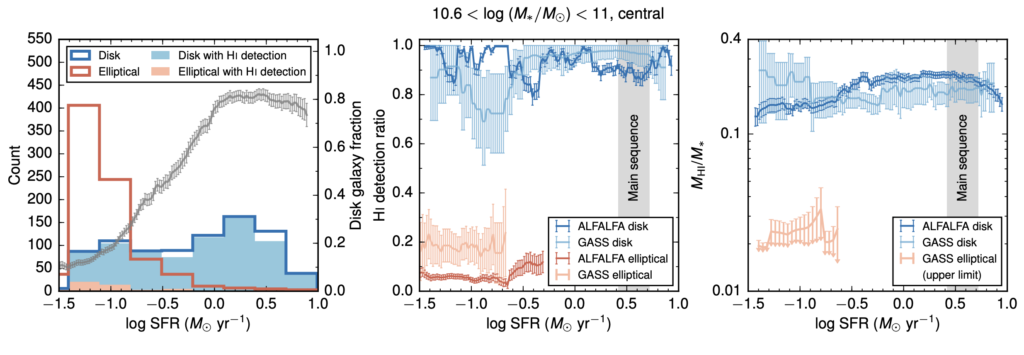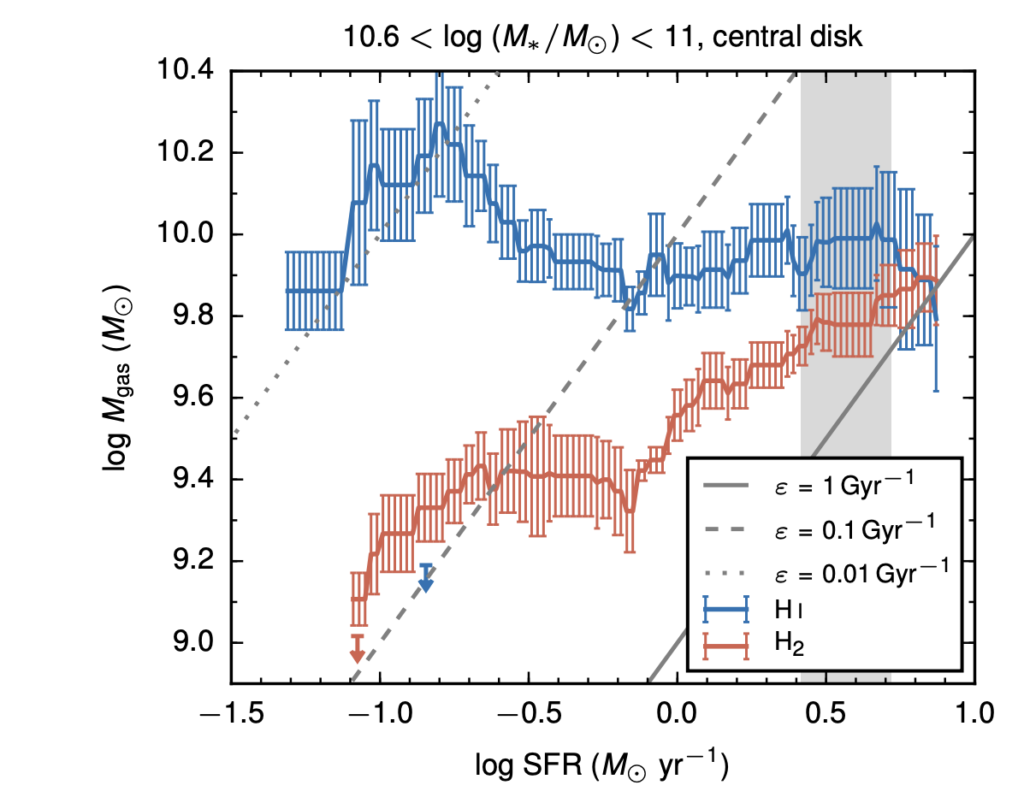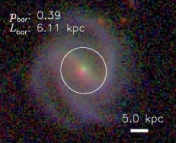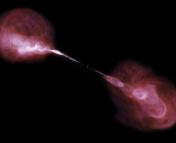Title: Nearly all Massive Quiescent Disk Galaxies have a Surprisingly Large
Atomic Gas Reservoir
Authors: C. Zhang, Y. Peng, L. C. Ho, R. Maiolino, A. Dekel, Q. Guo, F. Mannucci, D. Li, F. Yuan, A. Renzini, J. Dou, K. Guo, Z. Man, and Q. Li
First Author’s Institution: Kavli Institute for Astronomy and Astrophysics, Peking University
Status: Accepted to Astrophysical Journal Letters, open access on ArXiv
A concept fundamental in astronomy is that stars form from cold, dense molecular gas clouds. Applied to the formation and evolution of galaxies, star-formation is understood as being directly supported by an abundance of this cold molecular gas. We find that in star-forming galaxies — typically disk-like with blue spiral arms – there is a large reservoir of this cold molecular gas from which rapid star-formation can be sustained. Quiescent galaxies on the other hand – typically elliptical-like with red colors – do not actively form stars. Hence, they have been long thought to have only a scarce supply of cold molecular gas, likely as a result of either vigorous star-formation in the past, some sort of gas reservoir removal event, or a combination of the two.
There is overwhelming evidence that star-forming and quiescent galaxies inhabit very different environments in our universe. While star-forming galaxies are generally found alone or in small groups, quiescent galaxies are often found residing in large galaxy clusters with tens to hundreds of cluster members. This so-called morphology-density relation tells us something fundamental about the role of environment in shaping galaxy properties. In particular, it suggests that the cluster environment influences the ceasing (or quenching) star-formation.

The largest and most massive galaxies typically reside near the center of a cluster. We label them “central” galaxies to contrast them with smaller “satellite” galaxies with reside in the cluster outskirts. Most massive central galaxies are quiescent. One mechanism which has been proposed to explain this cessation of star-formation in these particularly massive central galaxies is so-called hot-halo quenching. In this scenario, a massive central galaxy is kept from refreshing its supply of cold molecular gas from their surroundings because the immense gravitational force experienced by the gas as it enters the halo of the central galaxy is so great that it becomes shock heated. Although still accreted into the central galaxy, the now hot gas becomes unsuitable to form stars.
Today’s paper discusses new and surprising findings about the gas content of these massive central galaxies, and why they are kept from forming stars.
A statistically large sample of nearby massive (1010.6 – 1011 M*) central galaxies was carefully selected from the Sloan Digital Sky Survey (SDSS). Instead of focusing on just typical giant central galaxies which have elliptical morphologies, the authors chose to examine the ellipticals side-by-side with little appreciated massive central disk galaxies. These kinds of galaxy cross-breeds are extremely rare, but potentially interesting objects for understanding the complex and poorly-understood mechanisms which drive star-formation cessation. Morphological classifications of elliptical and disk galaxies were taken from the citizen science project Galaxy Zoo, which crowd-sources galaxy classification through an online web platform accessible to anyone.
However, the SDSS data is only half the story. The SDSS galaxies were crossed matched with deep centimeter-wavelength surveys (ALFALFA and GASS) in order to obtain measurements of the atomic gas (H I) in these galaxies. While the atomic gas is too hot to directly form stars, given the right conditions it may cool down into molecular gas (H2).

The study reports a surprising finding: nearly all massive central disk galaxies have exceedingly large atomic gas reservoirs, especially when compared to those of ellipticals, as shown in Figure 2. Not only this, but massive disk galaxies with high star-formation rates have almost the same atomic gas mass compared to those with lower star-formation rates. In other words, massive quiescent central disk galaxies are as abundant in atomic gas as star-forming ones.
Importantly, this implies that massive quiescent central disk galaxies do indeed have the raw gas supply necessary to form stars. The lack of star-formation then must either be due to a marked inefficiency in converting atomic gas into molecular gas, difficulty in forming stars from the molecular gas, or both.

A complementary investigation of the cold molecular gas content of these massive central disk galaxies with the COLD GASS survey suggests that reservoirs of cold molecular gas are, unsurprisingly, significantly smaller for central disk galaxies with low star-formation rates, and vice-versa. While this is consistent with our current picture of star-formation, it contrasts sharply with the related finding that atomic gas mass does not change with star-formation rate, as shown in Figure 3.
Taken together, this investigation into the gas content of massive central disk galaxies illustrates that although their atomic gas content is universally large compared to central ellipticals, their star-formation cessation is still driven by a dearth of cold molecular gas. Yet, the precise mechanism keeping the atomic gas from eventually giving way to star-formation remains elusive.





Indeed unexpected! All researchers who care about quenching should keep this result in mind.
I am wondering about the elemental composition of the molecular gas vs the atomic gas; and if the elemental composition changes with the amount of gas.
PLEASE let me know if someone has something to say about my comment. I am extremely curious about this.